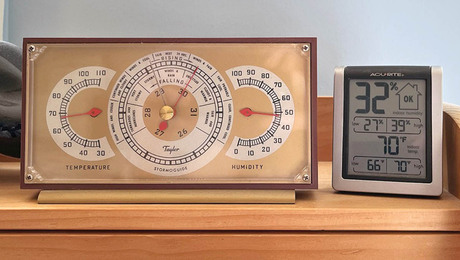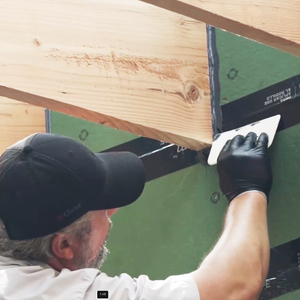Anyone have any clue of the bearing capacity of an 8″ sonotube with a 24″ bigfoot?
A crew I supervise jumped the gun and dug footings for a covered porch before the permit was in hand. I called the BI, and he said, “no big deal, I’ll come out and take a look (pre pour inspection).
So he looks, and says we can’t pour. Says the middle pier might have to be switched to a 12″ or 14″ sonotube. It has a 24″ bigfoot, and per their website, the soil as enough bearing capacity.
The porch in question is 7×17. Center pier should get 3000 lbs at psf on both roof and deck. Seems crazy, don’t you think? If someone accidentally piled a railroad car on the roof, wouldn’t the 6 x 6 wood post sitting on it fail long before the 8″ pier.
Opinions?


















Replies
I don't see the problem. A 7x17 porch is a tiny load.
The limiting factor would be the size of the footer and the bearing capacity of the soil, not the diameter of the pier. Say average soil conditions are 2000 psf. The footer is capable of 6280 lbs. (pi*r squared*2000).
How big is the post? 3000 lbs on a 4x4 would have a cross section of 12.25 square inches. That would be about 245 psi at the post bottom. A 6x6 would have a load of about 100 psi at the post bottom.
Isn't the compressive strength of concrete 3000-4000psi? I don't think a 245 psi load is going to crumble that 8" pier.
Steve
"Isn't the compressive strength of concrete 3000-4000psi? "Depends on the mix. Anywhere from 2000 to 5000 in easily had crete. Special stuff can do more better, but this inspectator is off his rocker.
Welcome to the Taunton University of Knowledge FHB Campus at Breaktime. where ... Excellence is its own reward!
Isn't bigger - better?How about a solid cube of concrete 2'x2'x to the frost depth, #5 bar both ways top and bottom and an embedded Simpson post base like a CBSQ66-SDS2?
Shore biggah be bettah.but he be more than good now.
Welcome to the Taunton University of Knowledge FHB Campus at Breaktime. where ... Excellence is its own reward!
Yesterday I thought sure he was crazy. Now having had some time to mull it over, I betcha he is caught in the middle of office politics. There is a new plans examiner who is an absolute code ####. The BI is probably afraid of approving ANYTHING unless it already has a permit.Interestingly, I first got into trouble when I brought the plans into the office. The original submittal was for an 7 x 18' deck, and the woman taking the app warned me that any porch over 120 square feet would require either a continuous wall footing or an engineers stamp if piers. (I changed it to 7 x 17. We have probably built 10 similar porches in the last 3 years an never run into that. The handout she gave me also stated that we needed to provide load calcs. I guess we didn't know how good we had it.
Our codes dept. has stepped it up in the last couple of years too. Now anything over a 20K project must have an engineers approval. Pretty brute-force approach to solving badly engineered stuff. How about the codes officer looking at the plans and decides if engineering is really needed? You can spend 20K on bathroom facelift without blinking an eye, and it don't need no stinkin' engineer...Steve
That dollar figure is meaning less. a 20K invoice won't cover painting some of the houses around here.
Welcome to the Taunton University of Knowledge FHB Campus at Breaktime. where ... Excellence is its own reward!
Exactly. That's the stupidest metric you could possibly use to determine if engineering is needed.
But it isa lazy metric that any recieving clrk can apply at a glance with no need for plan readers time
Welcome to the Taunton University of Knowledge FHB Campus at Breaktime. where ... Excellence is its own reward!
Just have the customer get the permit at 15k. It is not like they will check! Meaningless number, needs a meaning less answer.
>>Just have the customer get the permit at 15k<<I'm the contractor, I draw the plans, I get the permit, I deal with the inspectors.Actually the first time I hit this metric was last fall when I pulled a permit for a screen porch. I filled out the form and valued it at 30K. That was when I was first informed of the 20K trigger. So I said, well let's change that to 19K. The clerk gave me the evil eye and said, "we're not stupid, ya know". The project of course grew and wound up at closer to 60K.Actually I have no problem running anything by an engineer, but dollar amount as a trigger is just plain meaningless.Steve
I think here it is according to size.(sqft)
>any porch over 120 square feet would require either a continuous wall footing or an engineers stamp if piers<
is that in the IRC or is it a local ordinance/amedment? If IRC got a ref?
I was given a page at building safety that I believe had a reference to the IRC. It's back at the office, so I'll have to wait until Monday to double check it. I did a bit of searching on the net with no luck.
If you can remember it, i I sure would appreciate it. I've been leafing through the book here and not seeing anything on it.
I stopped in the office today and got it. As usual, my memory is not exactly photographic. The letter says:"Additions to residences over 120 square feet in area must be constructed on a continuous foundation system meeting the requirements for foundations in the 2007 Minnesota State Building Code which includes the prescriptive provisions in IRC chapter 4 or the foundation system must be designed and plans stamped by a Minnesota licensed structural engineer.Applications for additions to be constructed on posts which are 120 s.f. or less in area must include, in addition to other submittal requirements, detailed roof and floor framing plans, a complete footing diagram, and elevation drawings for every side of the proposed addition. Design calculations for footings and beams supporting floor and roof loads using design criteria for the City of Duluth must be submitted with the application."So it doesn't sound like they got this from the IRC. Anyone else seen something like this?Mind you, I submitted for an open porch, but their stance is that someone might come along and enclose it. Which I guess makes sense, cause I have seen plenty of effed up porches that were enclosed long after they were built.
thanks for the info
chapter 4 covers wood foundations as well as CC & CMU, if you wanted to someday through them a curve... but I don't have much confidence in wood foundations.
I can't argue with they're forecasting future enclosures. Especially in your colder climates and cabin fever as the winters progress into June.
I might try to see if my engineer would educate me (covering his costs) as to what he expects in the future for calcs & drawings in hopes that you can run the numbers & drawings yorself and he do the checking 'til satisfied enough to stamp it.
I think the problem is the word addition. I think it could be argued that the meaning in the code is not to lump deck with addition!
Right. But from their point of view once you put a roof on it, it's an addition and not a deck.
I still think they are misinterpreting the intent. But what do I know?
A friend of mine wanted to make the front of his house more eye appealing decided to put two decorative/false dormers on main house and garage, and then re-roof it [ dormers made like ''California style'']small 4/12 16 foot wide. BI said no way and wanted a architect to draw something up or sign off with a letter, architect said no problem structurally I'll sign off with a form letter and signature for $140 bucks and a $40 permit
Edited 8/29/2009 11:22 am ET by daveytree
That does sound pretty arbitrary, but there have been several deck collapses in the last few years that brought attention to how poorly some are built.
Plenty of building inspectors have no construction experience, and wouldn't know that an 8" pier is obviously big enough. On the other hand, if you (or anyone) doesn't know how to show load calcs, maybe the inspector isn't so crazy after all? Just sayin'....
I've never had a "problem" with BIs, because I've always tried to work with them. If one did have a problem ( like in your pier question) I'd say "no problem" and just get one new tube. Recut the four 2xs around the bottom to hold the new tube in place and have him "OK" that one. It also helps to have a copy of the plan on site to show the BI WHAT you are working on. And IF the plan has a "stamp" on it and YOU are following that plan to the "T", they won't gripe too much." Although I have the right to remain stupid, I try not to abuse that right"
sounds like your inspecter is crazy. if bigfoot said your soil can carry the load with their 24" footing, you won't have a problem with a 8" tube. here's the math
8" tube = 50.27 sq in w/3000psi concrete = 150,810 lbs burst strenght
12" tube = 113.1 sq in w/ 3000psi concrete = 339,300 lbs burst strenght
14" tube = 153.93 sq in w/ 3000psi concrete = 461,790 lbs burst strenght
i would use the 12" tube, it gives you a little extra room to work on. the cost in material isn't much if your only doing 3 piers.
I generally think of a fir post as supporting 1500 PSI. Concrete well exceeds that. Is the 8" tube unusually tall?
Not long no. Maybe six inches out of the ground. Total of five feet deep. The posts above are 6x6's. I could be in for a hard ride. My town has some new plans examiners who are following the law to the letter. And this BI is a nice guy but his response to this pier leads me to wonder. Not much I can do now but grin and bear it.
Just finished a 12X20 deck. Ledged to the house foundation a three 8" piers with 24x24 footings.
Drawn by the engineer and accepted by the city.
Is his concern the bearing capacity of the footing or the strength of the concrete pier?
You mention that he said you might have to swap the 8" sonotube out for something bigger- that doesn't sound like he's concerned about the footing, but the pier strength.
In our area, we are allowed to assume 1,500 PSF soil bearing capacity with no soil test to back it up.
Jon Blakemore
RappahannockINC.com Fredericksburg, VA
But you cant argue with government, there are going be in charge of your health care